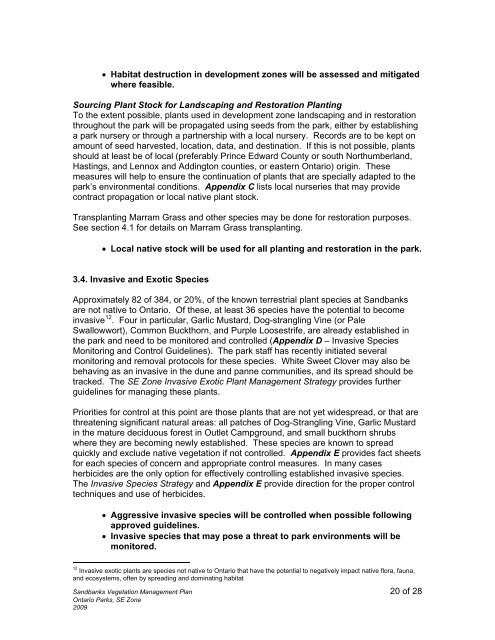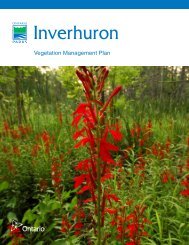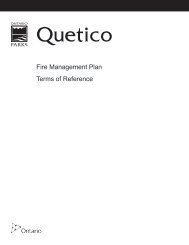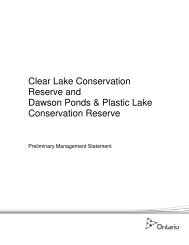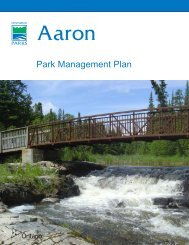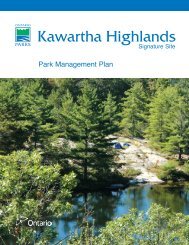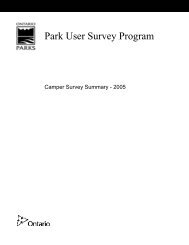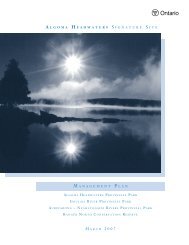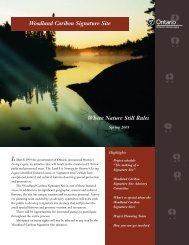Sandbanks Draft Veg Mgmt Plan - Ontario Parks
Sandbanks Draft Veg Mgmt Plan - Ontario Parks
Sandbanks Draft Veg Mgmt Plan - Ontario Parks
You also want an ePaper? Increase the reach of your titles
YUMPU automatically turns print PDFs into web optimized ePapers that Google loves.
• Habitat destruction in development zones will be assessed and mitigated<br />
where feasible.<br />
Sourcing <strong>Plan</strong>t Stock for Landscaping and Restoration <strong>Plan</strong>ting<br />
To the extent possible, plants used in development zone landscaping and in restoration<br />
throughout the park will be propagated using seeds from the park, either by establishing<br />
a park nursery or through a partnership with a local nursery. Records are to be kept on<br />
amount of seed harvested, location, data, and destination. If this is not possible, plants<br />
should at least be of local (preferably Prince Edward County or south Northumberland,<br />
Hastings, and Lennox and Addington counties, or eastern <strong>Ontario</strong>) origin. These<br />
measures will help to ensure the continuation of plants that are specially adapted to the<br />
park’s environmental conditions. Appendix C lists local nurseries that may provide<br />
contract propagation or local native plant stock.<br />
Transplanting Marram Grass and other species may be done for restoration purposes.<br />
See section 4.1 for details on Marram Grass transplanting.<br />
• Local native stock will be used for all planting and restoration in the park.<br />
3.4. Invasive and Exotic Species<br />
Approximately 82 of 384, or 20%, of the known terrestrial plant species at <strong>Sandbanks</strong><br />
are not native to <strong>Ontario</strong>. Of these, at least 36 species have the potential to become<br />
invasive 12 . Four in particular, Garlic Mustard, Dog-strangling Vine (or Pale<br />
Swallowwort), Common Buckthorn, and Purple Loosestrife, are already established in<br />
the park and need to be monitored and controlled (Appendix D – Invasive Species<br />
Monitoring and Control Guidelines). The park staff has recently initiated several<br />
monitoring and removal protocols for these species. White Sweet Clover may also be<br />
behaving as an invasive in the dune and panne communities, and its spread should be<br />
tracked. The SE Zone Invasive Exotic <strong>Plan</strong>t Management Strategy provides further<br />
guidelines for managing these plants.<br />
Priorities for control at this point are those plants that are not yet widespread, or that are<br />
threatening significant natural areas: all patches of Dog-Strangling Vine, Garlic Mustard<br />
in the mature deciduous forest in Outlet Campground, and small buckthorn shrubs<br />
where they are becoming newly established. These species are known to spread<br />
quickly and exclude native vegetation if not controlled. Appendix E provides fact sheets<br />
for each species of concern and appropriate control measures. In many cases<br />
herbicides are the only option for effectively controlling established invasive species.<br />
The Invasive Species Strategy and Appendix E provide direction for the proper control<br />
techniques and use of herbicides.<br />
• Aggressive invasive species will be controlled when possible following<br />
approved guidelines.<br />
• Invasive species that may pose a threat to park environments will be<br />
monitored.<br />
12<br />
Invasive exotic plants are species not native to <strong>Ontario</strong> that have the potential to negatively impact native flora, fauna,<br />
and ecosystems, often by spreading and dominating habitat<br />
<strong>Sandbanks</strong> <strong>Veg</strong>etation Management <strong>Plan</strong> 20 of 28<br />
<strong>Ontario</strong> <strong>Parks</strong>, SE Zone<br />
2009


